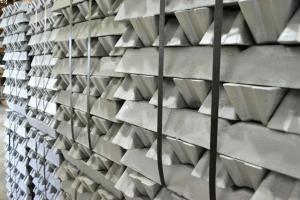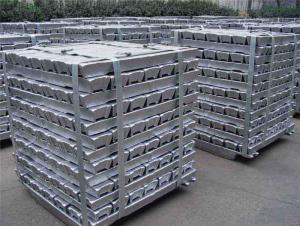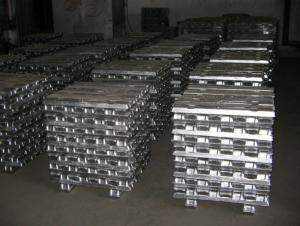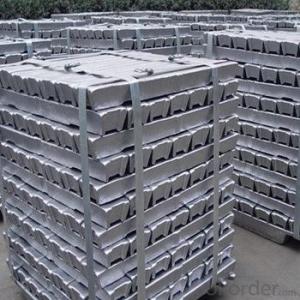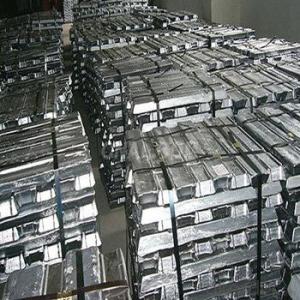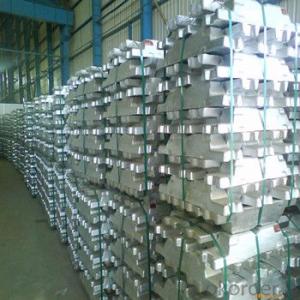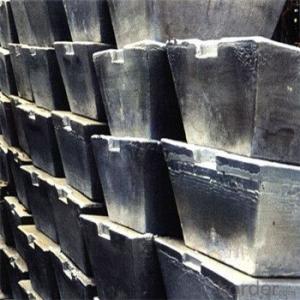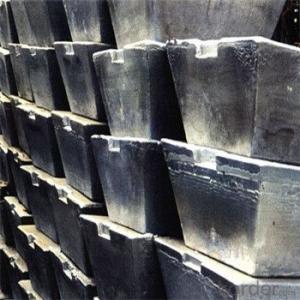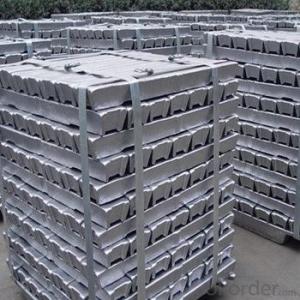Aluminum Ingots AA5182
- Loading Port:
- Shanghai
- Payment Terms:
- TT or LC
- Min Order Qty:
- 20 Tons m.t.
- Supply Capability:
- 1000 Sets Per Month m.t./month
OKorder Service Pledge
Quality Product, Order Online Tracking, Timely Delivery
OKorder Financial Service
Credit Rating, Credit Services, Credit Purchasing
You Might Also Like
1. Specifications of Aluminum Ingots AA5182
| Product Name | Aluminum Ingot |
| Chemical Composition | Al |
| Weight | 20/25kg |
| Al (Min) | 99%-99.9% |
| Appearance | silvery white |
| Advantages | easy control and operation, fast melting |

2. Usage/Application of Aluminum Ingots AA5182
A. mainly used for melting ingot
B. discontinuous melting with scrap
3.Packaging & Delivery of Aluminum Ingots AA5182
About 25Kg /Ingot, Packed in wooden case, Net weight 1000Kg/ Case, or as customer's requirements.
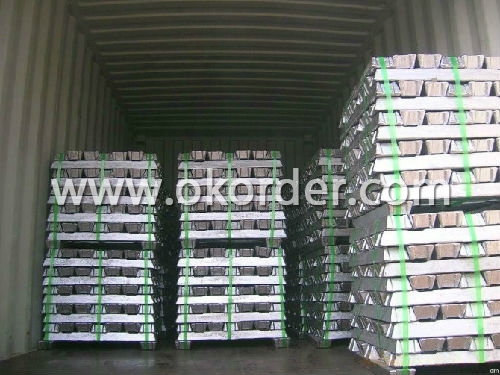
- Q:Casting aluminum ingot, environmental protection has those requirements?.
- The air cooler and pulse bag filter system are all negative pressure systems, and the draft fan is placed behind the dust removal system. Calcium carbide furnace, furnace, ferrosilicon furnace flue gas first enters the air cooler, the air cooler cooling, cooling to the full temperature range of bag filter can bear, enter into the bag pulse dust collector, after the dust of the flue gas from the chimney fan discharge, discharge from the dust hopper.
- Q:What are the challenges in recycling aluminum ingots?
- Recycling aluminum ingots presents several challenges that need to be addressed. To begin with, a major obstacle is the collection and sorting of aluminum waste. Unlike paper or plastic, aluminum waste is often mixed with other materials, making separation and sorting difficult. This necessitates the use of advanced sorting technologies and manual labor, which can be time-consuming and expensive. Additionally, the energy-intensive nature of aluminum production poses a challenge. Although recycling aluminum requires less energy than primary production, it still requires a significant amount of electricity. The process of melting down and purifying aluminum ingots requires high temperatures, which consume a considerable amount of energy. Furthermore, contamination is a persistent issue in recycling aluminum ingots. Even with advanced sorting technologies, it is difficult to guarantee that recycled aluminum is free from impurities. Contaminants like paint, coatings, or other metals can negatively impact the quality of the final product, making it less appealing to manufacturers. Moreover, transportation logistics present another challenge in the recycling process. Aluminum ingots are heavy and bulky, making their transportation from collection centers to recycling plants costly and challenging. This adds to the overall expenses of recycling. Lastly, the global market demand for recycled aluminum can fluctuate, making it challenging for recyclers to find buyers for their ingots. Economic factors, such as the price of primary aluminum and the demand for recycled materials in the market, can impact the profitability and feasibility of recycling aluminum ingots. Despite these challenges, recycling aluminum ingots remains a crucial practice due to its environmental benefits and the conservation of valuable resources. Continued research and innovation in recycling technologies can help overcome these challenges and make the process more efficient and cost-effective.
- Q:102 non-standard aluminum ingot is like? And ordinary non-standard aluminum ingot what is the difference?
- Ordinary non-standard aluminum ingot is the tube you use, regardless of your standard, with miscellaneous aluminum recovery smelting out of the aluminum ingot.
- Q:Process description of aluminium ingot
- Casting alloy ingots must be clarified for more than 30min. After cleaning, the slag can be cast. When casting, the furnace of the mixing furnace is aligned with the second and third moulds of the casting machine, so as to ensure the change of the liquid flow and a certain flexibility when changing the die. Furnace eyes and casting machine with a groove connection groove shorter is better, it can reduce the oxidation of aluminum, avoid vortex and splash, casting machine above disable 48h, restart, will die at 4h. The liquid aluminum mold with a shovel into the groove, the surface of liquid aluminum oxide film is removed, called slag. Flow with the first mock exam, will move down a chute mould casting machine is a continuous progress. The mould is moved in sequence, and the aluminum liquid is cooled gradually. When the casting machine reaches the middle of the casting machine, the aluminum liquid has been solidified into aluminium ingot, and the smelting number is printed by the printer. When the aluminum ingot reaches the top of the casting set, it has been completely solidified into aluminum ingot. At this time, the mold is turned over and the ingot is released and dropped on the automatic ingot car. The stacker is automatically stacked and bundled to become the finished aluminum ingot. The casting machine is cooled by spraying water, but must be started in the casting machine, turn full circle before water can be supplied. The aluminum liquid consumes about 8-10t water per ton, and a blower is needed to cool the surface in summer. The casting ingot belongs to the flat mold casting, the solidification direction of the aluminum liquid is from bottom to top, and the upper part is solidified at last, leaving a groove depression. The solidification time and the condition of each part of the aluminium ingot are different, so their chemical composition will be different, but it is in conformity with the standard as a whole.
- Q:What is the difference between remelting aluminium ingot and alloy aluminium ingot?
- General remelting aluminum ingot is a waste aluminum melting by boiler, is a small factory recycling processing! The standard alloy aluminium ingot is made of A00 aluminum according to the requirement and various metal proportion
- Q:What are the environmental impacts of producing aluminum ingots?
- The environmental impacts associated with the production of aluminum ingots are diverse. One major concern revolves around the extraction of bauxite, the primary ore used in aluminum production. The mining process, which often involves deforestation and habitat destruction, leads to the loss of biodiversity and disrupts ecosystems. Refining bauxite into alumina, a precursor to aluminum, demands significant amounts of energy. Typically, this energy is sourced from non-renewable fuels like coal or natural gas, resulting in greenhouse gas emissions and contributing to climate change. Subsequently, electrolysis is employed to convert alumina into aluminum metal, necessitating substantial electricity consumption. If this electricity is generated from fossil fuel-based power plants, it further exacerbates greenhouse gas emissions. Nevertheless, some aluminum smelters are transitioning to renewable energy sources, which aids in reducing their carbon footprint. The production of aluminum ingots also generates waste and by-products. The residue left after extracting alumina, known as red mud, possesses high alkalinity. If not properly managed, this residue can pose risks to soil and water quality and harm aquatic life if it enters nearby water bodies. Moreover, the transportation of bauxite, alumina, and aluminum ingots over long distances contributes to carbon emissions and air pollution. The extraction and production processes may also require the utilization of chemicals and other resources, which, if not properly managed, can have negative impacts on local ecosystems and water sources. In conclusion, the production of aluminum ingots entails various environmental impacts, including deforestation, greenhouse gas emissions, waste generation, and potential water and soil pollution. However, the industry is actively striving to address these concerns through the adoption of renewable energy, improved waste management practices, and resource efficiency measures.
- Q:How are aluminum ingots used in the production of architectural facades?
- Aluminum ingots play a crucial role in the production of architectural facades. These ingots are the primary raw material used to manufacture various aluminum products, including facades. To begin with, the ingots are melted and then cast into different shapes and forms, such as sheets or extrusions, depending on the design requirements of the facade. This casting process allows for customization and flexibility in creating architectural elements with different sizes, profiles, and finishes. Once the aluminum is transformed into its desired form, it undergoes further processing, such as cutting, bending, and machining, to achieve the specific design details required for the facade. This flexibility allows architects and designers to create intricate patterns, shapes, and textures, enhancing the overall aesthetic appeal of the building's exterior. Additionally, aluminum ingots possess excellent strength-to-weight ratio and corrosion resistance properties. These characteristics make aluminum an ideal choice for architectural facades as it can withstand harsh weather conditions, including heavy rain, strong winds, and extreme temperatures, without compromising its structural integrity. Moreover, aluminum facades are known for their durability and low maintenance requirements. The corrosion resistance of aluminum ensures that the facade can retain its original appearance for an extended period, reducing the need for frequent repairs or replacements. Furthermore, aluminum is a sustainable material as it can be recycled repeatedly without losing its quality. This recyclability aspect makes it an environmentally-friendly choice for architectural facades, aligning with the increasing focus on sustainable construction practices. In conclusion, aluminum ingots are essential in the production of architectural facades due to their versatility, strength, durability, and sustainability. The ability to mold aluminum into various shapes and forms allows for the creation of visually appealing and functional facades that withstand the test of time and contribute to sustainable building practices.
- Q:What are the energy requirements for producing aluminum ingots?
- The energy requirements for producing aluminum ingots can vary depending on several factors such as the type of production process, the source of energy used, and the efficiency of the production facility. However, generally, the production of aluminum ingots is an energy-intensive process. The primary method for producing aluminum ingots is through the smelting of aluminum oxide, or alumina, which is obtained from bauxite ore. The most common method used is the Hall-Héroult process, which involves the electrolysis of alumina dissolved in a molten cryolite electrolyte. In this process, a significant amount of energy is required to heat the alumina to its melting point of around 2,040 degrees Celsius and maintain it at this temperature. The energy is typically provided by large electric currents passed through the molten electrolyte, where the electrolysis takes place. Additionally, the production of aluminum ingots requires a substantial amount of electrical energy to break the chemical bonds in the alumina and separate the aluminum metal from the oxygen. The electrolysis process consumes a substantial amount of electricity, making aluminum production one of the largest consumers of electrical energy worldwide. The energy requirements for producing aluminum ingots can also be influenced by the source of electricity used. If renewable energy sources such as hydropower, wind power, or solar power are utilized, the environmental impact and carbon footprint of aluminum production can be significantly reduced. On the other hand, if the electricity is generated from non-renewable sources such as coal or natural gas, the energy requirements may be higher and contribute to higher greenhouse gas emissions. Efficiency improvements and technological advancements have been made in aluminum production processes over the years, leading to reductions in energy consumption. For example, the development of pre-baked anode technology has increased the energy efficiency of the Hall-Héroult process. Furthermore, recycling aluminum requires significantly less energy compared to primary production from bauxite ore, making it a more sustainable and energy-efficient option. In conclusion, the energy requirements for producing aluminum ingots are substantial due to the high temperatures required for the smelting process and the electricity needed for electrolysis. However, advancements in technology and the utilization of renewable energy sources can help reduce the energy consumption and environmental impact of aluminum production.
- Q:What are cooked aluminium ingots and aluminium ingots? What specifications do they have?
- Comparison of pure aluminium, aluminium containing up to 99.3% - 99.7%, such as iron, silicon, copper content of impurities is less than 1%, aluminum boxes, aluminum pot, aluminum sheet for daily use is cooked made of aluminium.
- Q:Where can I get aluminium ingots in cans?
- Because the cans of printing, transportation, recycling process, there will be a lot of impurities, so to purify.
We are a well-known enterprise specializing in the production and sales of aluminum sheets and coils.
Since the establishment of us, we have been devoted to setting up a good CIS and completely implementing ISO9001 quality management system.
1. Manufacturer Overview |
|
|---|---|
| Location | Henan,China |
| Year Established | 1993 |
| Annual Output Value | Above US$200 Million |
| Main Markets | Mid East;Eastern Europe;North America |
| Company Certifications | ISO 9001:2000;ISO 14001:2004;OHSAS 18001 |
2. Manufacturer Certificates |
|
|---|---|
| a) Certification Name | |
| Range | |
| Reference | |
| Validity Period | |
3. Manufacturer Capability |
|
|---|---|
| a)Trade Capacity | |
| Nearest Port | Shanghai |
| Export Percentage | 30%-50% |
| No.of Employees in Trade Department | 21-50 People |
| Language Spoken: | English;Chinese |
| b)Factory Information | |
| Factory Size: | Above 100,000 square meters |
| No. of Production Lines | Above 10 |
| Contract Manufacturing | OEM Service Offered;Design Service Offered |
| Product Price Range | Average |
Send your message to us
Aluminum Ingots AA5182
- Loading Port:
- Shanghai
- Payment Terms:
- TT or LC
- Min Order Qty:
- 20 Tons m.t.
- Supply Capability:
- 1000 Sets Per Month m.t./month
OKorder Service Pledge
Quality Product, Order Online Tracking, Timely Delivery
OKorder Financial Service
Credit Rating, Credit Services, Credit Purchasing
Similar products
New products
Hot products
Related keywords
